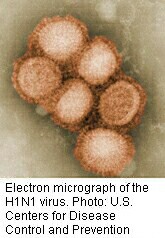
MONDAY, Sept. 10 (HealthDay News) — A new report shows that a deadly swine flu virus can infect ferrets, highlighting the importance of continuous surveillance of emerging flu strains.
Scientists in South Korea, working closely with researchers in the United States, found that a particular flu strain, common among pigs and known as Sw/1204, caused death within 10 days of inoculation in ferrets. The virus is also transmittable by respiratory droplets, through coughing or sneezing, making it potentially highly contagious.
Ferrets are considered the best animal model for studying the flu because they’re susceptible to the same virus strains as are humans and show similar symptoms.
Should people start to worry?
“This is not a run-for-the-hills situation,” explained study co-author Richard Webby, director of the World Health Organization Collaborating Center for Studies on the Ecology of Influenza in Animals and Birds at St. Jude Children’s Research Hospital, in Memphis. “The study adds value to our surveillance and helps us better prioritize our control measures.”
Swine flu, endemic among pigs worldwide, can be transferred between pigs, birds and humans. Pigs are considered “genetic mixing vessels,” which means they’re great at brewing new and potentially dangerous viruses.
The study authors say the findings show the pandemic potential of the TRSw influenza viruses that the researchers isolated from Korean pig slaughterhouses. TRSw viruses are Korean “triple-reassortant swine” H1N2 and H3N2, genetically related to strains seen in North America. “Triple” viruses, first detected in 1998 in the United States, were found to have genetic segments from swine, human and bird viruses. Sw/1204 is one of these “triple” viruses.
The researchers used a process called reverse genetics, which allows them to manipulate the virus’ genome to better understand its pathogenicity and transmissibility.
The study pinpointed two specific mutations of the virus responsible for its virulence that have been suspected but not previously proven, said Nancy Cox, director of the influenza division at the U.S. Centers for Disease Control and Prevention. “These viruses were already on our radar screen,” she explained.
Cox said that it’s rare that these particular viruses affect humans, though they can. “Is this virus with these two mutations likely to infect pigs, and then infect people, causing a widespread pandemic? Because there’s a lot of immunity in pigs to these viruses, it’s unlikely to infect humans,” she explained.
Dr. Bruce Hirsch, attending physician in infectious disease at North Shore University Hospital in Manhasset, N.Y., said one of the direct benefits of the study is that the virus’ “genetic signature can now be used in surveillance studies” to help researchers identify potential risks.
“Flu is a real threat, very, very dynamic and continuing to evolve and to change,” said Hirsch. “We need to understand what’s out there and whether it can affect our health.”
Webby advises people to get the flu vaccine this fall. “While we’re not concerned that this virus is spreading, the vaccine helps protect against some viruses circulating in swine.”
More information
Learn more about seasonal flu from the U.S. Centers for Disease Control and Prevention.

